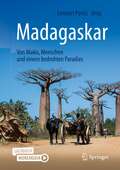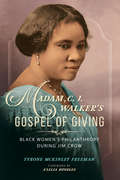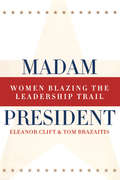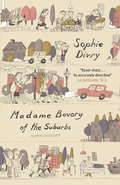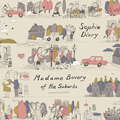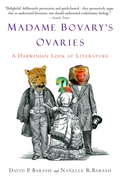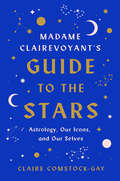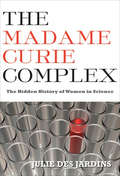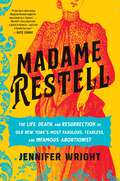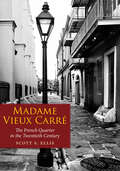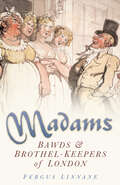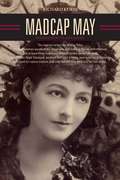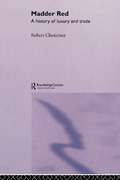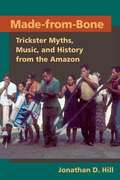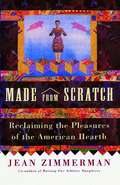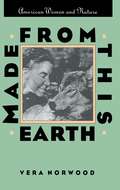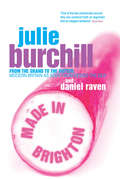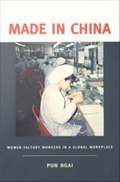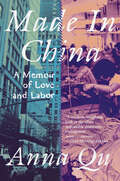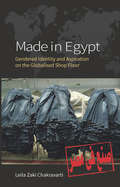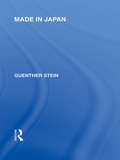- Table View
- List View
Madagaskar - Von Makis, Menschen und einem bedrohten Paradies
by Lennart PyritzEin Buch, das Madagaskar in seinen vielfältigen Facetten zeigt, untermalt mit ausgezeichneten Fotos. Angesprochen werden alle reise- und naturbegeisterten Leser. Ein tagebuchartiger, amüsant geschriebener Erfahrungsbericht über eine 14-monatige biologische Feldarbeit in Madagaskar in Form kurzer Texte (siehe: www.spektrumdirekt.de/madagaskar) ist ergänzt durch zahlreiche hochqualitative Fotos. Hauptsächlich biologische Themen werden erörtert, aber auch Erfahrungen mit madagassischer Kultur, Land und Leuten. Einzelne Abschnitte werden durch allgemeinverständlich geschriebene Infoboxen von Experten zum jeweiligen Thema ergänzt. Den zweiten Teil des Buches bildet eine Sammlung von Essays mit Fotos, ein madagassisches Zitat am Anfang führt hin zu madagassischer Fauna, Flora, Naturschutz, Geschichte, Politik, Kultur und Lebensweise. Verfasst sind die Beiträge von Autoren wie Prof. Peter Kappeler vom Deutschen Primatenzentrum, Dr. Roland Hilgartner, Leiter des Affenbergs Salem, und seiner madagassischen Frau Mamisolo sowie Dr. Christoph Schwitzer vom Zoo Bristol und Madagaskar-Koordinator der IUCN SSC Primate Specialist Group.
Madam C. J. Walker's Gospel of Giving: Black Women's Philanthropy during Jim Crow (New Black Studies Series)
by Tyrone McKinley FreemanFounder of a beauty empire, Madam C. J. Walker was celebrated as America's first self-made female millionaire in the early 1900s. Known as a leading African American entrepreneur, Walker was also devoted to an activist philanthropy aimed at empowering African Americans and challenging the injustices inflicted by Jim Crow. Tyrone McKinley Freeman's biography highlights how giving shaped Walker's life before and after she became wealthy. Poor and widowed when she arrived in St. Louis in her twenties, Walker found mentorship among black churchgoers and working black women. Her adoption of faith, racial uplift, education, and self-help soon informed her dedication to assisting black women's entrepreneurship, financial independence, and activism. Walker embedded her philanthropy in how she grew her business, forged alliances with groups like the National Association of Colored Women, funded schools and social service agencies led by African American women, and enlisted her company's sales agents in local charity and advocacy work. Illuminating and dramatic, Madam C. J. Walker’s Gospel of Giving broadens our understanding of black women’s charitable giving and establishes Walker as a foremother of African American philanthropy.
Madam President, Revised Edition: Women Blazing the Leadership Trail (American History Ser.)
by Eleanor Clift Tom BrazaitisFirst Published in 2003. Routledge is an imprint of Taylor & Francis, an informa company.
Madame Bovary of the Suburbs
by Sophie DivryThe story of a woman's life, from childhood to death, somewhere in provincial France, from the 1950s to just shy of 2025. She has doting parents, does well at school, finds a loving husband after one abortive attempt at passion, buys a big house with a moonlit terrace, makes decent money, has children, changes jobs, retires, grows old and dies. All in the comfort that the middle-classes have grown accustomed to. But she's bored. She takes up all sorts of outlets to try to make something happen in her life: adultery, charity work, esotericism, manic house-cleaning, motherhood and various hobbies - each one abandoned faster than the last. But no matter what she does, her life remains unfocussed and unfulfilled. Nothing truly satisfies her, because deep down - just like the town where she lives - the landscape is non-descript, flat, horizontal.Sophie Divry dramatises the philosophical conflict between freedom and comfort that marks women's lives in a materialistic world. Our heroine is an endearing, contemporary Emma Bovary, and Divry's prose will remind readers of the best of Houellebecq, the cold, implacable historian who paints a precise portrait of an era and those who inhabit it and in doing so renders existence indelibly absurd.Translated from the French by Alison Anderson
Madame Bovary of the Suburbs
by Sophie DivryThe story of a woman's life, from childhood to death, somewhere in provincial France, from the 1950s to just shy of 2025. She has doting parents, does well at school, finds a loving husband after one abortive attempt at passion, buys a big house with a moonlit terrace, makes decent money, has children, changes jobs, retires, grows old and dies. All in the comfort that the middle-classes have grown accustomed to. But she's bored. She takes up all sorts of outlets to try to make something happen in her life: adultery, charity work, esotericism, manic house-cleaning, motherhood and various hobbies - each one abandoned faster than the last. But no matter what she does, her life remains unfocussed and unfulfilled. Nothing truly satisfies her, because deep down - just like the town where she lives - the landscape is non-descript, flat, horizontal.Sophie Divry dramatises the philosophical conflict between freedom and comfort that marks women's lives in a materialistic world. Our heroine is an endearing, contemporary Emma Bovary, and Divry's prose will remind readers of the best of Houellebecq, the cold, implacable historian who paints a precise portrait of an era and those who inhabit it and in doing so renders existence indelibly absurd.Translated from the French by Alison Anderson
Madame Bovary of the Suburbs
by Sophie DivryThe story of a woman's life, from childhood to death, somewhere in provincial France, from the 1950s to just shy of 2025. She has doting parents, does well at school, finds a loving husband after one abortive attempt at passion, buys a big house with a moonlit terrace, makes decent money, has children, changes jobs, retires, grows old and dies. All in the comfort that the middle-classes have grown accustomed to. But she's bored. She takes up all sorts of outlets to try to make something happen in her life: adultery, charity work, esotericism, manic house-cleaning, motherhood and various hobbies - each one abandoned faster than the last. But no matter what she does, her life remains unfocussed and unfulfilled. Nothing truly satisfies her, because deep down - just like the town where she lives - the landscape is non-descript, flat, horizontal.Sophie Divry dramatises the philosophical conflict between freedom and comfort that marks women's lives in a materialistic world. Our heroine is an endearing, contemporary Emma Bovary, and Divry's prose will remind readers of the best of Houellebecq, the cold, implacable historian who paints a precise portrait of an era and those who inhabit it and in doing so renders existence indelibly absurd.Translated from the French by Alison Anderson(P)2017 WF Howes Ltd
Madame Bovary's Ovaries: A Darwinian Look at Literature
by David P. Barash Nanelle BarashWhat can elephant seals tell us about Homer's Iliad? How do gorillas illuminate the works of Shakespeare? What do bloodsucking bats have to do with John Steinbeck? According to evolutionary psychologist David Barash and his daughter Nanelle, the answers lie in the most important word in biology: evolution. Just like every animal from mites to monkeys, our day-to-day behavior has been shaped by millions of years of natural selection. So it should be no surprise to learn that the natural forces that drive animals in general and Homo sapiens in particular are clearly visible in the creatures of literature, from Henry Fielding's Tom Jones all the way to Helen Fielding's Bridget Jones. Seen through the lens of evolutionary biology, the witty repartee of Jane Austen's courting couples, Othello's tragic rage, the griping of Holden Caulfield, and the scandalous indiscretions of Madame Bovary herself all make a fresh and exciting kind of sense. The ways we fall in--and out--of love, stand by our friends, compete against our enemies, and squabble with our families have their roots in biological imperatives we share not only with other primates but with an amazing array of other creatures. The result is a new way to read, a novel approach to novels (and plays) that reveals how human nature underlies literature, from the great to the not-so-great. Using the cutting-edge ideas of contemporary Darwinism, the authors show how the heroes and heroines of our favorite stories have been molded as much by evolution as by the genius of their creators, revealing a gallery of characters from Agamemnon to Alexander Portnoy, who have more in common with birds, fish, and other mammals than we could ever have imagined. As engaging and informative as a good story,Madame Bovary's Ovariesis both an accessible introduction to a fascinating area of science and a provocatively sideways look at our cherished literary heritage. Most of all, it shows in a delightfully enteraining way how science and literature shed light on each other.
Madame Clairevoyant's Guide to the Stars: Astrology, Our Icons, and Our Selves
by Claire Comstock-Gay"A fresh, profound, and fun way to look at all things astro while also making spot-on observations about your pop culture faves." —CosmopolitanA soulful exploration of the twelve astrological signs embodied by our living “stars”—from divas to philosophers, poets to punks—and the ways they can help us better understand ourselves and each other, from the wildly popular astrology columnist for New York magazine’s The Cut.Whether you believe in it or not, astrology’s job has never been to give us a preordained vision of the future, nor to sort us into twelve neat personality types, but to provide the tools and language for delving into our weirdest, best, most thorny contradictions, and for understanding ourselves and each other in our full complexity. The stars and the planets then are more like mirrors that show us who we are, that give us an understanding of how to be and how to move through the world; how certain people do it differently, and what we can learn by studying them.In Madame Clairevoyant’s Guide to the Stars, Claire Comstock-Gay brings the sky down to Earth and points to our popular “stars”—from Aretha Franklin to Mr. Rogers, from poets in Cancer to punk singers in Scorpio—to reveal what the sky has to teach us about being human. In this wise, lyrically written guide, she examines the twelve astrological signs, illuminating the ways each one is more complicated, beautiful, and surprising than you might have been told. Claire suggests that actually it’s okay, and even important, to be a seeker, to hunger for self-knowledge, and if astrology is the vehicle for that inquiry, so be it.Madame Clairevoyant’s Guide to the Stars offers a clear introduction to the basics and an innovative new framework for creatively using astrology to illuminate our lives on earth. It’s a road map to our internal world, yes, but Claire also reminds us that it’s still our job to navigate it. Combining both heavenly insights and the earthly wisdom of writers like Cheryl Strayed and Heather Havrilesky and the poetry of Patricia Lockwood and Mary Oliver, Madame Clairevoyant’s Guide to the Stars offers a fresh, profound, and fun way to look at ourselves and others, and perhaps see each more clearly. And in that way, this book is not just beautiful, but transformative.
The Madame Curie Complex: The Hidden History of Women in Science (Women Writing Science Ser.)
by Julie Des JardinsThe historian and author of Lillian Gilbreth examines the &“Great Man&” myth of science with profiles of women scientists from Marie Curie to Jane Goodall. Why is science still considered to be predominantly male profession? In The Madame Curie Complex, Julie Des Jardin dismantles the myth of the lone male genius, reframing the history of science with revelations about women&’s substantial contributions to the field. She explores the lives of some of the most famous female scientists, including Jane Goodall, the eminent primatologist; Rosalind Franklin, the chemist whose work anticipated the discovery of DNA&’s structure; Rosalyn Yalow, the Nobel Prize-winning physicist; and, of course, Marie Curie, the Nobel Prize-winning pioneer whose towering, mythical status has both empowered and stigmatized future generations of women considering a life in science. With lively anecdotes and vivid detail, The Madame Curie Complex reveals how women scientists have changed the course of science—and the role of the scientist—throughout the twentieth century. They often asked different questions, used different methods, and came up with different, groundbreaking explanations for phenomena in the natural world.
Madame Restell: The Life, Death, and Resurrection of Old New York's Most Fabulous, Fearless, and Infamous Abortionist
by Jennifer Wright**Longlisted for the Brooklyn Public Library Book Prize in Nonfiction (2023)** **An Amazon EDITOR'S PICK for BEST BOOKS OF 2023 SO FAR in BIOGRAPHY/MEMOIR and HISTORY** **An Amazon EDITOR'S PICK for BEST BOOKS OF THE MONTH (March 2023)** **A Bookshop.Org EDITOR'S PICK (March 2023)** &“This is the story of one of the boldest women in American history: self-made millionaire, a celebrity in her era, a woman beloved by her patients and despised by the men who wanted to control them.&” An industrious immigrant who built her business from the ground up, Madame Restell was a self-taught surgeon on the cutting edge of healthcare in pre-Gilded Age New York, and her bustling &“boarding house&” provided birth control, abortions, and medical assistance to thousands of women—rich and poor alike. As her practice expanded, her notoriety swelled, and Restell established her-self as a prime target for tabloids, threats, and lawsuits galore. But far from fading into the background, she defiantly flaunted her wealth, parading across the city in designer clothes, expensive jewelry, and bejeweled carriages, rubbing her success in the faces of the many politicians, publishers, fellow physicians, and religious figures determined to bring her down. Unfortunately for Madame Restell, her rise to the top of her field coincided with &“the greatest scam you&’ve never heard about&”—the campaign to curtail women&’s power by restricting their access to both healthcare and careers of their own. Powerful, secular men—threatened by women&’s burgeoning independence—were eager to declare abortion sinful, a position endorsed by newly-minted male MDs who longed to edge out their feminine competition and turn medicine into a standardized, male-only practice. By unraveling the misogynistic and misleading lies that put women&’s lives in jeopardy, Wright simultaneously restores Restell to her rightful place in history and obliterates the faulty reasoning underlying the very foundation of what has since been dubbed the &“pro-life&” movement. Thought-provoking, character-driven, boldly written, and feminist as hell, Madame Restell is required reading for anyone and everyone who believes that when it comes to women&’s rights, women&’s bodies, and women&’s history, women should have the last word.
Madame Vieux Carre: The French Quarter in the Twentieth Century
by Scott S. EllisCelebrated in media and myth, New Orleans's French Quarter (Vieux Carré) was the original settlement of what became the city of New Orleans. In Madame Vieux Carré, Scott S. Ellis presents the social and political history of this famous district as it evolved from 1900 through the beginning of the twenty-first century. From the immigrants of the 1910s, to the preservationists of the 1930s, to the nightclub workers and owners of the 1950s and the urban revivalists of the 1990s, Madame Vieux Carré examines the many different people who have called the Quarter home, who have defined its character, and who have fought to keep it from being overwhelmed by tourism's neon and kitsch. The old French village took on different roles—bastion of the French Creoles, Italian immigrant slum, honky-tonk enclave, literary incubator, working-class community, and tourist playground. The Quarter has been a place of refuge for various groups before they became mainstream Americans. Although the Vieux Carré has been marketed as a free-wheeling, boozy tourist concept, it exists on many levels for many groups, some with competing agendas. Madame Vieux Carré looks, with unromanticized frankness, at these groups, their intentions, and the future of the South's most historic and famous neighborhood. The author, a former Quarter resident, combines five years of research, personal experience, and unique interviews to weave an eminently readable history of one of America's favorite neighborhoods.
Madams: Bawds and Brothel-Keepers of London
by Fergus LinnaneAt a time when there were almost no career opening for women, a group of intrepid and gifted females scaled the heights of what was literally a man's world - they became brothelkeepers, or 'bawds', Mother Clap - women bawds were often known as Mother - ran male brothels, or Molly Houses. Elizabeth Holland had an immense moated mansion built on Bankside and for 30 years entertained the aristocracy, including royalty. When troops attempted to stop her trade and eject her from the house, she and her girls drove them off. The Georgian bawd Charlotte Hayes held a 'Cyprian Fete' at which gentlemen "of the highest breeding" first watched athletic young men copulating with nubile whores and then joined in themselves. Fergus Linnane reveals the other side of London's years of pomp and splendour, painting a vivid picture of the bawds, their girls, and their clients. Madams is fresh and original, offering humour, insight, and a very candid view of the sexual behaviour of Londoners through the ages.
Madcap May: Mistress of Myth, Men, and Hope
by Richard KurinMay Yohe was a popular entertainer from humble American origins who married and then abandoned a wealthy English Lord who owned the fabled Hope diamond--one of the most valuable objects in the world and now exhibited at the Smithsonian Institution in Washington, D.C. May was a romantic who had numerous lovers and at least three husbands--though the tabloids rumored twelve. One included the playboy son of the Mayor of New York. May separated from him--twice--and cared for her next husband, a South African war hero and invalid whom she later shot.Crossing the paths of Ethel Barrymore, Boris Karloff, Oscar Hammerstein, Teddy Roosevelt, Consuelo Vanderbilt, and the Prince of Wales, May Yohe was a foul-mouthed, sweet-voiced showgirl who drew both the praise and rebuke of Nobel laureate George Bernard Shaw. Nicknamed "Madcap May," she was a favorite of the press. In later years she faced several maternity claims and a law suit which she won. She was hospitalized in an insane asylum and escaped. She ran a rubber plantation in Singapore, a hotel in New Hampshire, and a chicken farm in Los Angeles. When all else failed, she washed floors in a Seattle shipyard, and during the Depression held a job as a government clerk. Shortly before her death, she fought, successfully, to regain her lost U.S. citizenship.How was this woman, May Yohe, able to charm her way to international repute, live an impossible life, and also find the strength to persevere in light of the losses she suffered--in wealth, citizenship, love, and sanity? Madcap May, assembled from her writings and historical interviews, archival records, newspaper stories, scrapbooks, photographs, playbills, theatrical reviews, souvenirs, and silent film, tells her heretofore lost story.
Madder Red: A History of Luxury and Trade (Caucasus World)
by Robert ChencinerMadder red is an ancient dyestuff, extracted from the root of the madder plant, growing in many countries around the world. The secret and devilishly complex Oriental dyeing process to obtain the lustrous colour known as Turkey Red was avidly sought by Europeans, from the time before the fall of Ancient Rome. It was finally cracked by the French about 1760, who were able to dye wool, silk and cotton bright red. After the lowlands of the Caspian Caucasus had been subdued by the Russians in the early 1800s, madder was cultivated there and rapidly became the main crop. The quest for Turkey Red went hand in hand with an avalanche of scientific research, which not only improved the yield of dyestuff from the roots but led to its chemical synthesis and in 1870 the collapse of the world-wide madder industry. Many of the nascent dye companies grew into chemical giants of our time. Further regional and cultural background may be found in Chenciner's Daghestan: Tradition and Survival, also published in the Caucasus World series.
Made from Bone: Trickster Myths, Music, and History from the Amazon
by Jonathan D. HillMade-from-Bone provides the first complete set of English translations of narratives about the mythic past and its transformations from the indigenous Arawak-speaking Wakuénai of southernmost Venezuela. The central character throughout these primordial times is a trickster-creator, Made-from-Bone, who survives a prolonged series of life-threatening attacks. Carefully recorded and transcribed by Jonathan D. Hill, these narratives offer scholars of South America and other areas the only ethnographically generated cosmogony of contemporary or ancient native peoples of South America.
Made from Scratch: Reclaiming the Pleasures of the American Hearth
by Jean ZimmermanA stunning celebration and reappraisal of the importance of "women's work," Made from Scratch addresses the tug that many Americans feel between our professional and private lives. In this stunning celebration and reappraisal of the importance of "women's work," acclaimed journalist Jean Zimmerman poignantly addresses the tug that many Americans of the twenty-first century feel between our professional and private lives. With sharp wit and intelligence, she offers evidence that in the current domestic vacuum, we still long for a richer home life -- a paradox visible in the Martha Stewart phenomenon, in the continuing popularity of women's service magazines such as Better Homes and Gardens, Family Circle, and Ladies' Home Journal -- whose combined circulation of over 17 million is nearly twice the combined circulation of Time, Newsweek, and U.S. News & World Report -- and the booming business of restorations, where onlookers get a hands-on view of domestic life as it flourished in past centuries. This book is about the ways home traditions passed from one generation to the next -- baking a birthday cake from scratch, cherishing family heirlooms, or discovering the satisfaction of piecing a quilt -- sustain our souls, especially in our ever more processed, synthetic world, where we buy "homemade" goods and fail to see the irony in that.Made from Scratch tells the story of the unsung heroines of the hearth, investigating the history of female domesticity and charting its cultural changes over centuries. Zimmerman traces the lives of her own family's homemakers -- from her tiny but indomitable grandmother, who managed a farm, strangled chickens with her bare hands, and sewed all the family clothing, to her mother, who rejected her country upbringing yet kept a fastidious suburban home where the gender divide stayed firmly in place, to her own experiences as a wife and mother weaned on the Women's Movement of the 1970s, with its emphatic view that housework was a dirty word and that the domestic sphere was to be fled rather than cherished. In this book Zimmerman questions the unexamined trade-off we have made in a shockingly brief time span, as we've "progressed" from home-raised chickens to frozen TV dinners to McNuggets from the food court at the mall. What is lost when we no longer engage, as individuals and as a community, in the ancient rituals of food, craft, and shelter?
Made from Scratch
by Jean ZimmermanIn this stunning celebration and reappraisal of the importance of "women's work," acclaimed journalist Jean Zimmerman poignantly addresses the tug that many Americans of the twenty-first century feel between our professional and private lives. With sharp wit and intelligence, she offers evidence that in the current domestic vacuum, we still long for a richer home life -- a paradox visible in the Martha Stewart phenomenon, in the continuing popularity of women's service magazines such as Better Homes and Gardens, Family Circle, and Ladies' Home Journal -- whose combined circulation of over 17 million is nearly twice the combined circulation of Time, Newsweek, and U.S. News & World Report -- and the booming business of restorations, where onlookers get a hands-on view of domestic life as it flourished in past centuries. This book is about the ways home traditions passed from one generation to the next -- baking a birthday cake from scratch, cherishing family heirlooms, or discovering the satisfaction of piecing a quilt -- sustain our souls, especially in our ever more processed, synthetic world, where we buy "homemade" goods and fail to see the irony in that.Made from Scratch tells the story of the unsung heroines of the hearth, investigating the history of female domesticity and charting its cultural changes over centuries. Zimmerman traces the lives of her own family's homemakers -- from her tiny but indomitable grandmother, who managed a farm, strangled chickens with her bare hands, and sewed all the family clothing, to her mother, who rejected her country upbringing yet kept a fastidious suburban home where the gender divide stayed firmly in place, to her own experiences as a wife and mother weaned on the Women's Movement of the 1970s, with its emphatic view that housework was a dirty word and that the domestic sphere was to be fled rather than cherished. In this book Zimmerman questions the unexamined trade-off we have made in a shockingly brief time span, as we've "progressed" from home-raised chickens to frozen TV dinners to McNuggets from the food court at the mall. What is lost when we no longer engage, as individuals and as a community, in the ancient rituals of food, craft, and shelter?
Made From This Earth
by Vera NorwoodThe broad sweep of environmental and ecological history has until now been written and understood in predominantly male terms. In Made From This Earth, Vera Norwood explores the relationship of women to the natural environment through the work of writers, illustrators, landscape and garden designers, ornithologists, botanists, biologists, and conservationists.Norwood begins by showing that the study and promotion of botany was an activity deemed appropriate for women in the early 1800s. After highlighting the work of nineteenth-century scientific illustrators and garden designers, she focuses on nature's advocates such as Rachel Carson and Dian Fossey who differed strongly with men on both women's "nature" and the value of the natural world. These women challenged the dominant, male-controlled ideologies, often framing their critique with reference to values arising from the female experience. Norwood concludes with an analysis of the utopian solutions posed by ecofeminists, the most recent group of women to contest men over the meaning and value of nature.
Made in America: A Social History of American Culture and Character
by Claude S. FischerOur nation began with the simple phrase, "We the People." But who were and are "We"? Who were we in 1776, in 1865, or 1968, and is there any continuity in character between the we of those years and the nearly 300 million people living in the radically different America of today? With Made in America, Claude S. Fischer draws on decades of historical, psychological, and social research to answer that question by tracking the evolution of American character and culture over three centuries. He explodes myths-such as that contemporary Americans are more mobile and less religious than their ancestors, or that they are more focused on money and consumption-and reveals instead how greater security and wealth have only reinforced the independence, egalitarianism, and commitment to community that characterized our people from the earliest years. Skillfully drawing on personal stories of representative Americans, Fischer shows that affluence and social progress have allowed more people to participate fully in cultural and political life, thus broadening the category of "American" -yet at the same time what it means to be an American has retained surprising continuity with much earlier notions of American character. Firmly in the vein of such classics as The Lonely Crowd and Habits of the Heart--yet challenging many of their conclusions--Made in America takes readers beyond the simplicity of headlines and the actions of elites to show us the lives, aspirations, and emotions of ordinary Americans, from the settling of the colonies to the settling of the suburbs.
Made in Baja: The Lives of Farmworkers and Growers behind Mexico's Transnational Agricultural Boom
by Christian ZlolniskiMuch of the produce that Americans eat is grown in the Mexican state of Baja California, the site of a multibillion-dollar export agricultural boom that has generated jobs and purportedly reduced poverty and labor migration to the United States. But how has this growth affected those living in Baja? Based on a decade of ethnographic fieldwork, Made in Baja examines the unforeseen consequences for residents in the region of San Quintín. The ramifications include the tripling of the region’s population, mushrooming precarious colonia communities lacking basic infrastructure and services, and turbulent struggles for labor, civic, and political rights. Anthropologist Christian Zlolniski reveals the outcomes of growers structuring the industry around an insatiable demand for fresh fruits and vegetables. He also investigates the ecological damage—"watercide”—and the social side effects of exploiting natural resources for agricultural production. Weaving together stories from both farmworkers and growers, Made in Baja provides an eye-opening look at the dynamic economy developing south of the border.
Made In Brighton: From the grand to the gutter: Modern Britain as seen from beside the sea
by Daniel Raven Julie BurchillBritain is experiencing a sudden reckless rush of liberalisation, from 24 hour licensing to gay marriages. But how did we get from idolising Grace Kelly and Prince Rainier to Jordan and Peter Andre? Funny and bittersweet, Made In Brighton interweaves personal stories of life in Brighton with larger themes of sex, politics and class to take a cold, hard look at the changing face of Britain, and at the town which has always been at the vanguard of Britain's cultural evolution. From punk to dance, dope to coke, the Labour party to hen parties, straight to gay to bi, this book holds a mirror up to the dazed face of Britain and gives it a good hard slap.
Made In China: Women Factory Workers In a Global Workplace
by Pun NgaiAs China has evolved into an industrial powerhouse over the past two decades, a new class of workers has developed: the dagongmei, or working girls. The dagongmei are women in their late teens and early twenties who move from rural areas to urban centers to work in factories. Because of state laws dictating that those born in the countryside cannot permanently leave their villages, and familial pressure for young women to marry by their late twenties, the dagongmei are transient labor. They undertake physically exhausting work in urban factories for an average of four or five years before returning home. The young women are not coerced to work in the factories; they know about the twelve-hour shifts and the hardships of industrial labor. Yet they are still eager to leave home. Made in China is a compelling look at the lives of these women, workers caught between the competing demands of global capitalism, the socialist state, and the patriarchal family. Pun Ngai conducted ethnographic work at an electronics factory in southern China's Guangdong province, in the Shenzhen special economic zone where foreign-owned factories are proliferating. For eight months she slept in the employee dormitories and worked on the shop floor alongside the women whose lives she chronicles. Pun illuminates the workers' perspectives and experiences, describing the lure of consumer desire and especially the minutiae of factory life. She looks at acts of resistance and transgression in the workplace, positing that the chronic pains--such as backaches and headaches--that many of the women experience are as indicative of resistance to oppressive working conditions as they are of defeat. Pun suggests that a silent social revolution is underway in China and that these young migrant workers are its agents.
Made in China: A Memoir of Love and Labor
by Anna QuA young girl forced to work in a Queens sweatshop calls child services on her mother in this powerful debut memoir about labor and self-worth that traces a Chinese immigrant's journey to an American future. <p><p> As a teen, Anna Qu is sent by her mother to work in her family's garment factory in Queens. At home, she is treated as a maid and suffers punishment for doing her homework at night. Her mother wants to teach her a lesson: she is Chinese, not American, and such is their tough path in their new country. But instead of acquiescing, Qu alerts the Office of Children and Family Services, an act with consequences that impact the rest of her life. Nearly twenty years later, estranged from her mother and working at a Manhattan start-up, Qu requests her OCFS report. When it arrives, key details are wrong. <p><p> Faced with this false narrative, and on the brink of losing her job as the once-shiny start-up collapses, Qu looks once more at her life's truths, from abandonment to an abusive family to seeking dignity and meaning in work. Traveling from Wenzhou to Xi'an to New York, Made in China is a fierce memoir unafraid to ask thorny questions about trauma and survival in immigrant families, the meaning of work, and the costs of immigration.
Made In Egypt: Gendered Identity and Aspiration on the Globalised Shop Floor
by Leila Zaki ChakravartiThis ground-breaking ethnography of an export-orientated garment assembly factory in Egypt examines the dynamic relationships between its managers - emergent Mubarak-bizniz (business) elites who are caught in an intensely competitive globalised supply chain - and the local daily-life realities of their young, educated, and mixed-gender labour force. Constructions of power and resistance, as well as individual aspirations and identities, are explored through articulations of class, gender and religion in both management discourses and shop floor practices. Leila Chakravarti's compelling study also moves beyond the confines of the factory, examining the interplay with the wider world around it.
Made in Japan (Routledge Library Editions: Japan)
by Guenther SteinThis volume concentrates on the effect of Japanese trade competition on the UK and Europe, it also provides an illuminating picture of political, social and military conditions in Japan in the early twentieth century.
